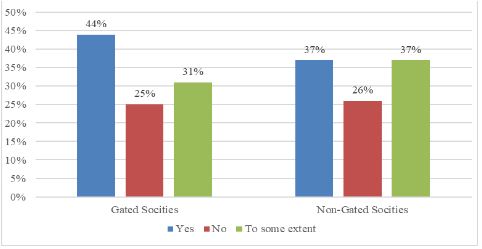Sense of Community among the Residents of Gated and Non-Gated Communities in Lahore, Pakistan
Abstract
 Abstract Views: 0
Abstract Views: 0
Planned gated and non-gated communities have appeared rapidly all over the world due to the public amenities and quality of life they offer. It is generally assumed that gated communities provide better security as compared to non-gated communities. However, population growth and urban sprawl have led to many social and physiological issues including the death of old city traditions, community identity, and lack of the sense of community (SOC). Thus, modern urban development faces the challenge of meeting the habitation and social needs of people with lesser face-to-face interaction and more mobile and fluid ways of communication. Lahore is the second largest city of Pakistan. It has experienced the growth of private sector led gated communities over several years. This research aims to compare their physical characteristics, as well as the perception of security, extent of social interaction, and the sense of community among their residents. For this purpose, the data of interviews with the residents of 4 selected gated and non-gated communities of Lahore was collected. The findings revealed that the sense of community is strongly associated with the extent of social interaction in both gated and non-gated communities. Contrary to what the literature generally suggests, this study found a higher sense of security among the residents of non-gated communities than gated communities. Finally, it was concluded that the participation of the residents in community development and management activities would promote more socially cohesive and vibrant communities.
Downloads
References
Adhikari, G. P. (2021). Calculating the sample size in quantitative studies. Scholar’s Journal, 4(1), 14–29. https://doi.org/10.3126/scholars.v4i1.42458
Bandauko, E., Kutor, S. K., Nyantakyi-Frimpong, H., Baiden, P., & Arku, G. (2023). Influence of socio-demographic factors and housing characteristics on satisfaction with privacy in gated communities in Accra (Ghana). Housing Studies, 38(10), 1781–1802. https://doi.org/10.1080/02673037.2022.2077920
Bint-e-Waheed, H., & Nadeem, O. (2020). Perception of security risk in gated and non-gated communities in Lahore, Pakistan. Journal of Housing and The Built Environment, 35(3), 897–915. https://doi.org/10.1007/s10901-019-09719-2
Boonjubun, C. (2019). Also the urban poor live in gated communities: A Bangkok case study. Social Sciences, 8(7), Article e219. https://doi.org/10.3390/socsci8070219
Chapman, D. W., & Lombard, J. R. (2006). Determinants of neighborhood satisfaction in fee-based gated and nongated communities. Urban Affairs Review, 41(6), 769–799. https://doi.org/10.1177/1078087406287164
Ewing, R., & Park, K. (Eds.). (2020). Basic quantitative research methods for urban planners. Routledge.
Farahani, L. M., & Lozanovska, M. (2014). A framework for exploring the sense of community and social life in residential environments. Archnet-IJAR, International Journal of Architectural Research, 8(3), 223–237. https://hdl.handle.net/10536/DRO/DU:30069682
Francis, J., Giles-Corti, B., Wood, L., & Knuiman, M. (2012). Creating sense of community: The role of public space. Journal of Environmental Psychology, 32(4), 401–409. https://doi.org/10.1016/j.jenvp.2012.07.002
George, D., & Mallery, P. (2019). IBM SPSS statistics 26 step by step: A simple guide and reference. Routledge.
Gul, Y., Sultan, Z., & Jokhio, G. A. (2018). The association between the perception of crime and walking in gated and non-gated neighbourhoods of Asian developing countries. Heliyon, 4(8), Article e00715. https://doi.org/10.1016/j.heliyon.2018.e00715
Jacob, P., & Chander, D. S. (2020). Impact of social interaction on residential satisfaction in gated communities in an Indian context. International Journal of Advanced Research in Engineering and Technology, 11(2), 48–56.
Kim, S. K. (2006). The gated community: Residents' crime experience and perception of safety behind gates and fences in the urban area [Doctoral dissertation, Texas A&M University]. Texas A&M University Libraries. https://hdl.handle.net/1969.1/4130
Li, X., Li, Z., Jia, T., Yan, P., Wang, D., & Liu, G. (2021). The sense of community revisited in Hankow, China: Combining the impacts of perceptual factors and built environment attributes. Cities, 111, Article e103108. https://doi.org/10.1016/j.cities.2021.103108
Link, F., Señoret, A., & Valenzuela, F. (2022). From community to public familiarity: Neighborhood, sociability, and belonging in the neoliberal city. Urban Affairs Review, 58(4), 960–995. https://doi.org/10.1177/10780874211021512
Lu, T., Zhang, F., & Wu, F. (2018). Place attachment in gated neighbourhoods in China: Evidence from Wenzhou. Geoforum, 92, 144–151. https://doi.org/10.1016/j.geoforum.2018.04.017
Manzi, T., & Smith, B. (2005). Gated communities as club goods: Segregation or social cohesion? Housing Studies, 20(2), 345–359. https://doi.org/10.1080/0267303042000331817
McMillan, D. W., & Chavis, D. M. (1986). Sense of community: A definition and theory. Journal of Community Psychology, 14(1), 6–23. https://doi.org/10.1002/1520-6629(198601)14:1%3C6::AID-JCOP2290140103%3E3.0.CO;2-I
Mousavinia, S. F. (2022). How residential density relates to social interactions? Similarities and differences of moderated mediation models in gated and non-gated communities. Land Use Policy, 120, Article e106303. https://doi.org/10.1016/j.landusepol.2022.106303
Mousavinia, S. F., Pourdeihimi, S., & Madani, R. (2019). Housing layout, perceived density and social interactions in gated communities: Mediational role of territoriality. Sustainable Cities and Society, 51, Article e101699. https://doi.org/10.1016/j.scs.2019.101699
Moustafa, Y. M. (2009). Design and neighborhood sense of community: An integrative and cross-culturally valid theoretical framework. Archnet-IJAR, International Journal of Architectural Research, 3(1), 71–91.
Rafiemanzelat, R. (2016). Gated communities and sense of community: A review on the social features of gated communities. International Journal of Electronics and Communication Engineering, 10(5), 671–676.
Rahmaan, A., & Anis, B. (2009). Dynamics of gated communities, their impact and challenges for sustainable development: A case study of Lahore, Pakistan. International Journal of Architectural Research, 3, 57–70.

Copyright (c) 2023 Obaidullah Nadeem, Rizwan Hameed, Pernia Ayyaub

This work is licensed under a Creative Commons Attribution 4.0 International License.
JAABE follows an open-access publishing policy and full text of all published articles is available free, immediately upon publication of an issue. The journal’s contents are published and distributed under the terms of the Creative Commons Attribution 4.0 International (CC-BY 4.0) license. Thus, the work submitted to the journal implies that it is original, unpublished work of the authors (neither published previously nor accepted/under consideration for publication elsewhere). On acceptance of a manuscript for publication, a corresponding author on the behalf of all co-authors of the manuscript will sign and submit a completed Copyright and Author Consent Form.
Copyright (c) The Authors





